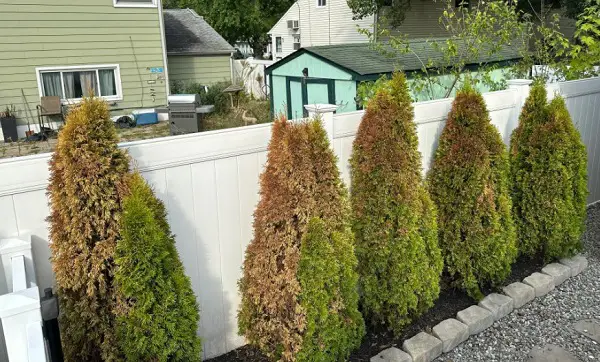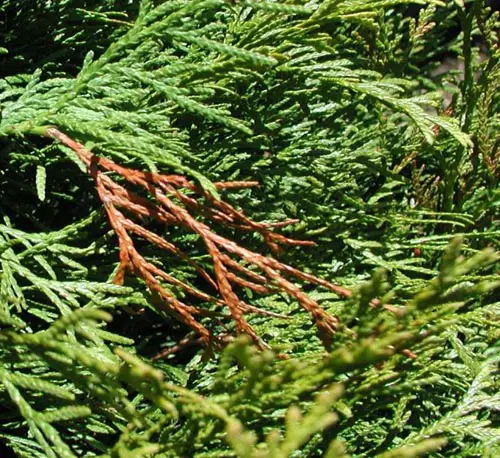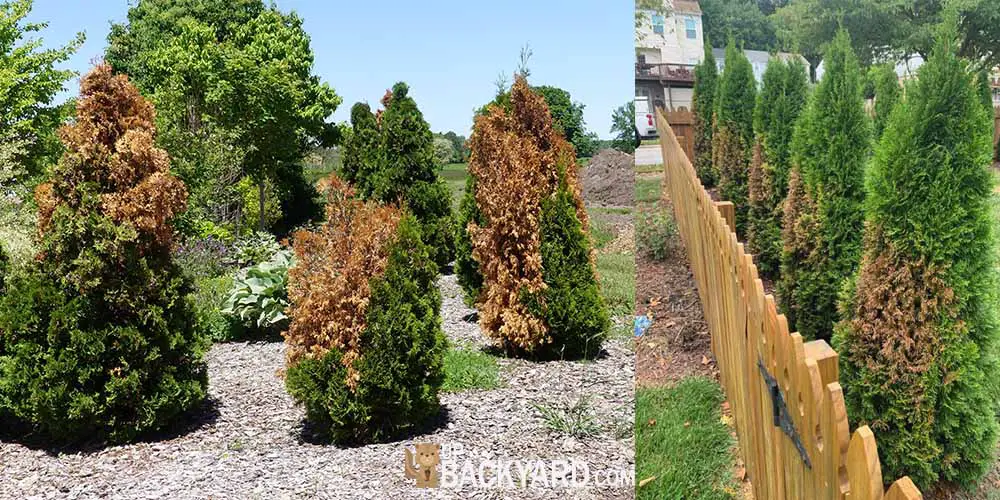Arborvitae is one of the many evergreen coniferous trees that are present in North America.
They are smaller in size which makes them perfect for having in your front yard. Commonly found alongside houses and lining business buildings, these trees add a nice green touch to any scenery.
It becomes frustrating when your arborvitae starts to turn brown. No one wants a yard where it looks like the plants are dying. To fix the problem, you have to know what is causing it.
Let’s look into why arborvitae turns brown!
Why is my Arborvitae Turning Brown?
When a plant starts to turn brown, that is a strong indicator that something is wrong with it.
Sadly, several problems that a plant can have will turn it brown, making it trickier to figure out the cause of the problem.
Arborvitae can suffer from many things that can turn them brown. From diseases to the plant not getting the nutrients it needs, several problems can be indicated by your tree turning brown.
Transplant Shock
Moving is hard no matter if you are a human or a tree. When people grow arborvitae in their yards, it’s not very often that they are growing the tree from a seed or even sapling.

Instead, these trees are usually transplanted to someone’s yard as medium/full-grown trees to continue growing in the new space.
During a tree’s moving process, it has to be uprooted from its original ground, placed onto a truck, deal with the bouncing of the road, and then reintroduced into the new ground. This is a lot for a tree to deal with.
If your arborvitae tree starts to turn brown soon after you first get it, the reason is most likely from transplant shock. The tree gets so stressed out that it starts the dying process.
To help your tree heal from this or to prevent it from happening, make sure that you dig a wider hole than the roots of the tree. Think to make the whole 3 times wider than the tree’s roots. Also, make sure there is plenty of water.
Once the tree is in the ground, surround the trunk (but don’t touch it) with about 3 inches of mulch. This protects the tree, keeps the roots warm and moist, and gives the tree a better transition to your lawn.
Using these methods will help make the transition for your tree much easier. If your arborvitae tree was already turning brown before making changes to its setup, it can take up to 5 years for your tree to fully heal.
You might like: When Is The Best Time To Fertilize Arborvitae? – (Best Season & Signs)
Fungal Diseases
Your arborvitae tree can turn brown if it becomes infected with a fungal disease. These diseases will work their way through the tree and spread death.

One of the first signs is that the tree will start to turn brown. Other indicators are highly dependent on the type of fungal disease it has.
For example, the Pestalotiopsis tip blight fungal disease will infect the tips of branches.
From the tips, the infection will spread to the base of the branches and then farther throughout the tree. Black bumps might form along the branches and overall won’t look very pretty.
Some fungal infections can be stopped by using fungicides on your tree. However, others have no cure and will kill the tree.
If your arborvitae has a disease where there isn’t a cure, it is best to remove the tree from the ground so other nearby trees don’t catch the disease.
Prevent fungal infections by keeping good care of your trees. Make sure they aren’t planted too close together, get the proper amount of water, and have a good layer of mulch around the trunk. This prevents water from getting trapped at the roots and is the perfect breeding ground for fungus.
Be careful when mowing the lawn and doing other landscaping work. Accidentally cutting the tree while mowing or doing another task makes the tree vulnerable to disease. Keep the tree healthy by keeping it free from damage.
Winter Burn
It may sound weird, but trees can get burned during the winter. The wind, temperatures, and sunlight all play together in the burning of a tree.
To be clear, a tree won’t literally burn in the Winter as it was set on fire. It is more like a sunburn on the needles of a tree that will make it look brown.
The first part of winter burn is the lack of moisture in the air. While coniferous trees have needles that are good for holding in moisture, they aren’t perfect. Moisture will still be released from the tree, but there isn’t as much moisture being returned.
Over the course of winter, the tree will dry out and can start to turn brown from how dry it is. Then, the wind doesn’t help as it also makes the air around the arborvitae much drier.
Finally, snow is a highly reflective surface. White is the color that reflects the most sunlight, so as the sun shines down in the winter and those rays bounce against the snow, they can pelt the tree. This can give it a tree sunburn which will cause further browning of the needles.
Drought
This is one of the more common reasons why an arborvitae tree will begin to turn brown. Coniferous trees can go longer without water than many other trees. However, they aren’t cacti, they still need to be regularly watered.
In times of a drought or if you forget to water your trees for a long time, they will dry out and begin to turn brown. Luckily, this problem has the easiest solution.
If you notice that your tree needs some more water, give it more water! However, make sure not to drown the tree in overcompensation.
When people fear that they aren’t giving their trees enough water, they might give the tree way more water than it needs to “make up” for the lost water.
This will only end up harming the tree more as it goes from one extreme to another. If your tree needs some more water, give it the normal amount of water or give it slightly less water than normal. If the drought was extreme, reintroduce water slowly to not send the tree into shock.
If you need more help figuring out what kind of problem your arborvitae tree has, check out this video for helpful information.
Frequently Asked Questions
Can Arborvitae Recover from Browning?
An arborvitae tree’s ability to recover from browning highly depends on what was causing it to brown. Your tree is much more likely to recover from a drought than it is from a harsh fungal infection.
Most of the time, you have to give your arborvitae time to recover after it has started to brown. If you aren’t able to give it more water or give it a fungicide depending on the problem, there isn’t a ton that you can do.
On the bright side, trees are resilient, and they will recover if they haven’t had too much damage. They can recover from shock, droughts, winter burns, and some diseases.
If you notice that your tree has sustained a lot of damage, either looking mostly brown or having open areas on the trunk, your tree might be too far gone. At this point, it would be better to remove the tree and replace it so the other trees don’t have problems as well.
How Do I Know if My Arborvitae is Overwatered?
We have discussed how after a drought; people might accidentally overwater their arborvitae. This can do just as much damage as the drought itself.
There are several indicators to show that your tree has been overwatered. If you don’t have mulch around the trunk, the ground might seem squishy from excess soil.
The needles on the tree will also become discolored and can die off. They will look brown or possibly yellowish. The needles will become weak and flimsy and might fall from the tree.
While yes, these trees need moist soil to thrive, they don’t want to be swimming.
How Often Should Arborvitaes Be Watered?
To prevent over or underwatering, know how often and how much you should be watering your tree.
When your arborvitae tree is getting established, water it twice a week. This gives them plenty of water to go through all of their roots so they can get established in the soil. After that point, give the tree ½-1 inch of water per week.
Final Thoughts
Arborvitae trees can make any building look a lot nicer by adding splashes of bright green. Yet, things can happen that make the tree begin to turn brown.
Now that you know what can make an arborvitae tree turn brown, you can better avoid this outcome.
Let us know in the comments if you have gotten your arborvitae tree to go back to green after turning brown. What did you do to help your tree?
